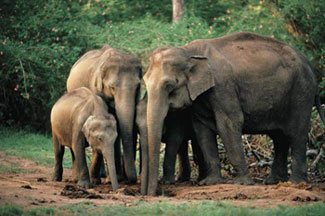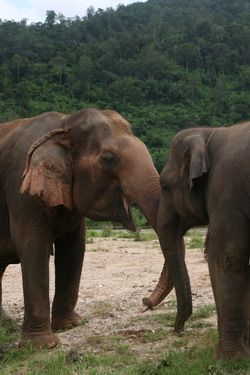In a terrific new study in this month’s BMC Ecology1, a team of researchers led by Shermin de Silva of the University of Pennsylvania Biology Department has published the results of extensive, multi-year research regarding the social dynamics of a population of Asian elephants (Elephas maximus) at Uda Walawe National Park in Sri Lanka. The researchers studied 286 adult female elephants from September 2006 to December 2008, observing the social relationships they formed on a one-to-one basis, in small groups, and at the overall population level.
While group social behavior in African savannah elephants (Loxodonta africana) has been studied extensively, this new research is the first detailed, quantitative study of a wild Asian elephant population over such a lengthy time period … and what the researchers found was quite surprising.

You spend all your time social networking! First do your homework, then you can go on Facebook (photo credit: HelpElephants.com)
Prior less comprehensive studies had suggested that Asian elephants form less complex social networks than do African savannah elephants, with Asian elephants forming smaller and looser social groups based primarily on mother/daughter bonds, and rarely if ever involving relationships between unrelated females. In this in-depth longitudinal study, though, a different, more nuanced, portrait of Asian elephant society emerged.
Although, on any given day, the researchers would see only small groups of elephants that didn’t appear to interact extensively, over time, individual elephants formed larger social units that could be remarkably stable across years, even while associations among such units varied quite a bit across seasons.
One-to-One Relationships (Dyads)
The researchers started out by measuring how much time pairs of adult females spent together and found that, at a high level, the frequency of their associations was highly correlated across all five seasons in the National Park (Sri Lanka has a highly seasonal environment, with two separate monsoon seasons, two dry seasons, and a transitional season) – that is, pairs who associated in one season tended to associate in all seasons, and those who did not associate in a given season weren’t likely to associate at all.

Yeah, let's just hang and make nice for now, then we'll hit the rice paddies when nobody's looking! (photo credit: EleAid.com)
In studying one-to-one relationships, the researchers turned their attention to 51 “core” elephants who they thought would provide particularly good data, since these elephants were observed frequently and during all seasons of the year. These elephants formed a total of 478 pair relationships, which the researchers divided out statistically as follows:
- A total of six (1.3%) of the pairings were “strong” and stable relationships, as measured by the relative percentage of time these pairs spent together during all seasons. Nine of the elephants (17.6%) participated in relationships in this category.
- A total of 433 (90.6%) of the pairings were “temporary,” with the association peaking during a single season (most of the peaks were in either the transitional or dry seasons). All 51 of the elephants had at least one relationship that fell into this category.
- A total of 39 (8.2%) of the pairings were “cyclical,” with the associations peaking in frequency during the two dry seasons (interesting, the researchers did not find relationships where the peaks were during the two wet seasons). Thirty two (62.7%) of the elephants had relationships that were cyclical.
Next, the researchers analyzed whether the identities of an elephants’ preferred companions changed over time. Overall, they found that the elephants spent slightly more than 20% of their time with their long-term companions (the top five companions over five seasons) and slightly more than 30% of their short-term companions (the top five for the current season). On an individual level, there was quite a bit of variation: eight (15.7%) of the elephants maintained 4 to 5 of their top five companions for all five seasons, while 16 (31.4%) completely changed their top-five companions during the study.
The researchers cite the example of two elephants, Kamala and Kanthi, who spent nearly all their time together – they were part of the “K” unit (Kamala, Kanthi, Karin, Kavitha and Kalyani, but no Kardashians) that was particularly close – and contrasted this kloseness to an individual named “471” that had few stable companions. (I wonder if this was due to distress over only receiving a number for a name.)
Additionally, the researchers noticed that the elephants who had the most relationships tended to form weaker bonds with each individual partner, whereas those with relatively few pairings tended to spend a relatively large amount of time with each of their companions.
Hmm, these elephants are beginning to sound quite a bit like people…
Small Group Associations (Ego Networks)
At the next level up, the researchers studied so-called “ego networks,” social networks consisting of an elephant and all of the other individual elephants with whom she associated at least once. The researchers focused on 88 of the adult females who they observed in every season, and calculated five measurements for each: (1) the number of her direct companions, (2) the number of ties between the direct companions, (3) the total number of potential ties between each of these direct companions, (4) the ratio of actual to potential ties, and (5) the number of individuals within two degrees of separation of the subject (number of friends plus number of “friends of friends”).
(Note that, assuming at least one of the researchers is within five degrees of separation of Kevin Bacon, this would mean that the entire ego network would be within seven degrees of separation of Kevin Bacon.)
Without getting into the full statistical analysis, the researchers’ principal conclusion was that:
[W]hile a subject’s direct companions do change over time, she has a few that are almost always present; even those that are not present continuously may have been companions in previous seasons. Thus, individuals maintain long-term relationships with others even though they may be apart for one or several seasons and [the amount of time spent together is small].
In other words, the elephants remember their friends and reestablish their relationships even after having been apart for long periods.
Population Level
Finally, the researchers looked at the social structure of the entire population. They found that the elephants in the overall popular had an extensive and well-connected social network, and that the distinct social units within the population were two to three times larger than had previously been seen in the field. Moreover, they observed that many of the social units maintained their integrity across seasons, even as individuals switched units and the connections between the units changed.
For those of you who like to look at dot patterns, below is a colorful series of diagrams depicting the connections between elephants, measured at different societal levels and during different seasons (T1 is the transitional season, D1 and D2 are the dry seasons, and W1 and W2 are, you guessed it, the wet seasons):
Recap
While the strength of the associations among these Asian elephants (as measured by percentage of time that individuals spent together) is generally a good bit lower than that of the associations among African savannah elephants, most of these elephants had a few strong ties as well as consistent ties that they maintained over several seasons. Further, the Asian elephants were hardly asocial – while their mix of companions did fluctuate over time, they often returned to a subset of preferred companions.
Moreover, through their years of observation and statistical analysis of the elephants at the population level, the researchers found that the elephants’ social units were much larger than had been observed in prior studies, and that these social units were more stable across the years than were the companions of individual elephants.
The researchers speculated that one reason for the surprising findings is that the elephants stay in touch in ways that are hard for humans to detect, allowing the elephants to maintain bonds and relationships that we fail to observe. For example, elephants can communicate acoustically over great distances, and often use scent to follow one another’s paths at night (and, for that matter, even when the other elephants would be in plain sight, at least from the human perspective).
Finally, the researchers are planning to perform a detailed genetic study of the population in order to analyze the degree to which relatedness impacts the social organization of Asian elephant society. We’ll be waiting!
_____
1de Silva, S., Ranjeewa, A., & Kryazhimskiy, S. (2011). The dynamics of social networks among female Asian elephants BMC Ecology, 11 (1) DOI: 10.1186/1472-6785-11-17.


